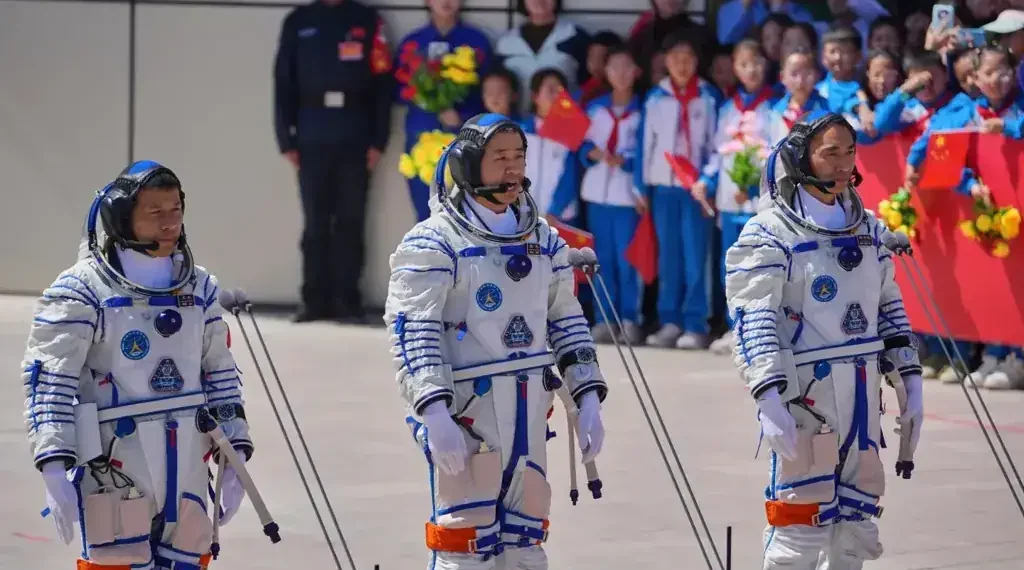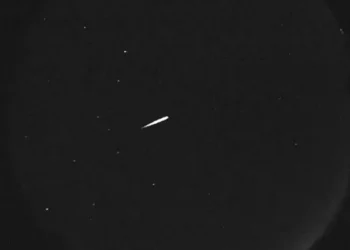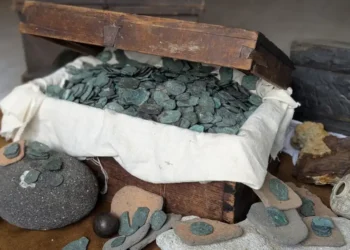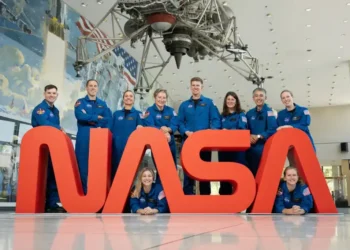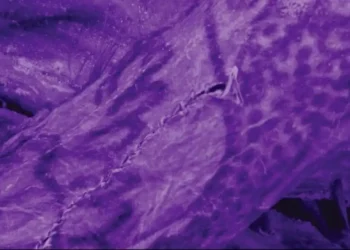China Prepares Return of Stranded Tiangong Astronauts After Space Debris Incident
China’s space agency says three astronauts who remained aboard the Tiangong station after a debris strike damaged their original spacecraft will return to Earth on Friday using the Shenzhou-21 vehicle. The crew, who launched in April for a six-month mission, remained in orbit for nearly two additional weeks while engineers assessed their return options. Authorities say the astronauts are healthy and the station remains fully operational.
Background on the Mission
The three astronauts — Chen Dong, Chen Zhongrui, and Wang Jie — have been living aboard the Tiangong space station since April as part of China’s long-duration Shenzhou program. Their mission, designed for routine scientific research and station maintenance, followed the established six-month rotation model used during previous Shenzhou flights.
China has pursued a steady human-spaceflight schedule since launching its first astronauts in 2003. The Tiangong station, completed in 2022, is the centerpiece of these efforts and allows China to operate continuous crewed missions similar to the International Space Station model. According to China’s Manned Space Engineering Office, each rotation supports biological, medical, materials, and technology experiments that contribute to China’s long-term exploration plans, including a human lunar landing target set for 2030.
Space Debris Incident Disrupts Planned Return
Initial Return Plan Interrupted
The astronauts were slated to return to Earth four days after the arrival of their replacement crew on 1 November. Such handovers help maintain uninterrupted operations aboard Tiangong, ensuring that experiments, maintenance, and station monitoring continue without gaps.
However, shortly before the crew’s planned departure, mission controllers observed irregularities in the Shenzhou-20 spacecraft. According to state media reports citing Chinese space officials, engineers believe the vessel was struck by a small piece of orbiting debris, a growing concern for all spacefaring nations as Earth’s orbit becomes increasingly congested with defunct satellites, rocket fragments, and micrometeoroids.
Space Debris: A Rising Global Risk
Space debris is one of the most persistent hazards for crewed missions, with agencies including NASA, ESA, and the United Nations Office for Outer Space Affairs warning of rising collision risks in low-Earth orbit. Even millimeter-sized fragments can compromise spacecraft integrity due to their extreme velocities, often exceeding 25,000 kilometers per hour.
While China has not released detailed technical assessments of the Shenzhou-20 impact, the decision to abort the spacecraft’s return indicates concerns about capsule safety. The incident underscores broader discussions among space agencies about the need for enhanced debris-tracking systems and internationally coordinated cleanup efforts.
Shenzhou-21 Spacecraft to Bring Crew Home
Backup Vehicle Already Docked at Tiangong
The solution came from the Shenzhou-21 spacecraft, which brought the new crew to the station on 1 November. The vessel remains docked at Tiangong as part of standard mission design, providing a safe and fully operational return vehicle.
State media reports that Shenzhou-21 has already been inspected and confirmed ready to support the journey back to Earth. The astronauts are scheduled to depart on Friday, marking the end of an extended mission that lasted beyond the typical rotation period.
Crew Condition Rated “Good”
In a statement released Tuesday, the China Manned Space Engineering Office said the astronauts remained “in good condition, working and living normally” throughout the unexpected extension. Mission procedures prioritize regular health checks, exercise routines, and psychological support, ensuring that astronauts maintain physical fitness during prolonged stays in microgravity.
Their ability to continue research activities despite the return delay reflects the stability of Tiangong’s onboard systems and the maturity of China’s human-spaceflight operations.
Scientific Research Continues Aboard Tiangong
Biological Experiments Mark New Milestone
The Shenzhou-21 mission also carried several research payloads, including laboratory mice, marking the first time China has brought live mammals beyond Earth for extended biological experiments. Similar studies conducted on the ISS by NASA and ESA help scientists understand how microgravity affects organs, muscles, reproduction, and aging.
These experiments are part of China’s broader ambitions to expand its scientific portfolio in space, particularly as it prepares for more complex missions to the moon and eventually Mars. Long-term biological research is considered essential for developing life-support systems and understanding the physiological challenges of deep-space travel.
China’s Growing Role in Global Space Activity
Over the past two decades, China has invested heavily in its space program, developing the Long March rocket series, establishing lunar exploration missions, and landing the first rover on the far side of the moon in 2019. Tiangong’s continuous operation places China among the few nations capable of long-duration crewed missions, alongside the United States and Russia.
While China is not a partner in the International Space Station due to restrictions imposed by the U.S. Congress, it has sought international collaboration on scientific experiments and may open Tiangong to foreign astronauts in the future.
Next Steps and Broader Implications
The astronauts’ return aboard Shenzhou-21 will likely follow the standard descent profile, involving onboard thruster adjustments, atmospheric reentry, and touchdown in China’s Inner Mongolia region, the typical landing site for Shenzhou capsules. Medical teams and recovery crews will be deployed to assist the astronauts immediately upon landing.
The debris strike incident may prompt additional analysis and monitoring procedures for future missions. Global experts, including the European Space Agency’s Space Debris Office, have repeatedly called for improved mapping, collision avoidance systems, and international policies to mitigate orbital hazards.
As space activity accelerates — with new constellations, private sector launches, and national exploration programs — protecting astronauts and spacecraft from debris will remain a shared challenge. China’s rapid response and logistics in this incident illustrate its evolving capacity to manage complex in-orbit contingencies while keeping long-term scientific and exploration goals on track.
This article was rewritten by JournosNews.com based on verified reporting from trusted sources. The content has been independently reviewed, fact-checked, and edited for accuracy, tone, and global readability in accordance with Google News standards.
Stay informed with JournosNews.com — your trusted source for verified global reporting and in-depth analysis. Follow us on Google News, BlueSky, and X for real-time updates.
JournosNews.com follows Google News content standards with original reporting, verified sources, and global accessibility. Articles are fact-checked and edited for accuracy and neutrality.
